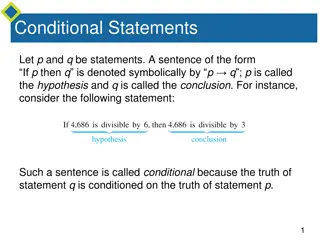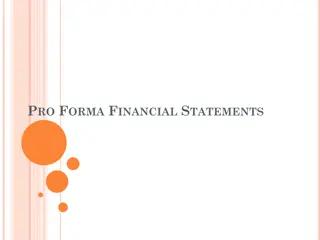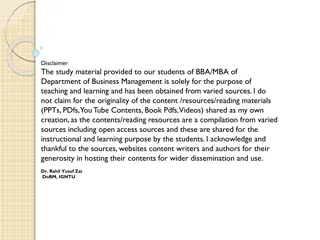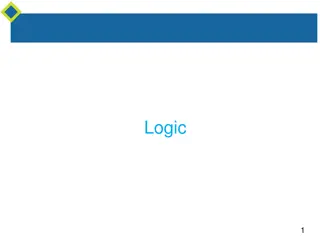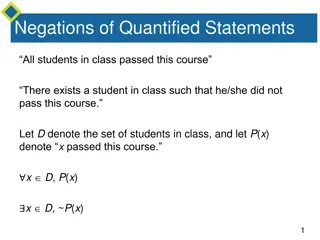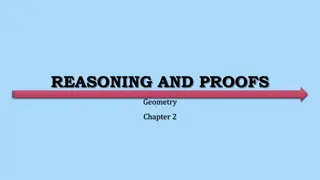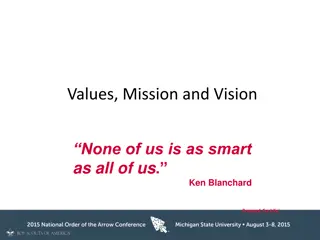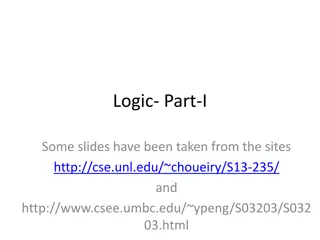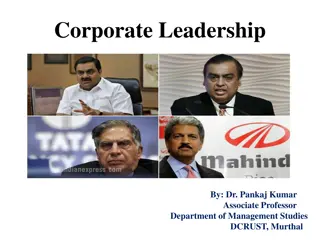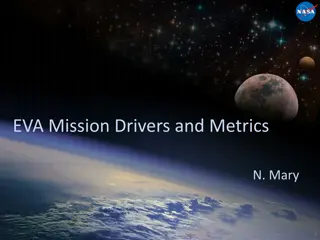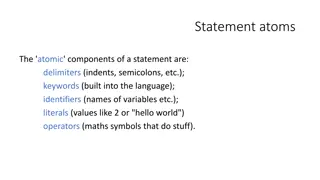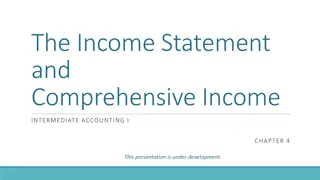Understanding Mission and Vision Statements in Organizations
A mission statement encapsulates an organization's core purpose and objectives, while a vision statement outlines aspirations and future direction. The mission focuses on "what" and "how," while the vision emphasizes the "why." Combining both statements creates a unified reason for existence, guiding internal decisions and aligning efforts. Crafting a clear vision involves motivating people, coordinating actions efficiently, and matching the company's capabilities. Similarly, defining the mission entails explaining the business's meaning, purpose, and desired achievements in harmony with the external and internal environment.
Download Presentation

Please find below an Image/Link to download the presentation.
The content on the website is provided AS IS for your information and personal use only. It may not be sold, licensed, or shared on other websites without obtaining consent from the author. Download presentation by click this link. If you encounter any issues during the download, it is possible that the publisher has removed the file from their server.
E N D
Presentation Transcript
Mission and Vision defining
What is a Mission Statement? A mission statement is a short summary of an organization s core purpose, focus, and aims. This usually includes a brief description of what the organization does and its key objectives. What is a Vision Statement? A vision statement is a short description of an organization s aspirations and the wider impact it aims to create. It should be a guiding beacon to everyone within the organization and something which underpins internal decision-making and determines the intended direction of the organization. What s the Difference Between a Mission Statement and a Vision Statement? In short: The mission is the what and the how, and the vision is the why. The mission statement defines what an organization does. The vision statement, meanwhile, should clarify the aspirations of the organization and define the direction it s heading in. Many organizations combine the two statements to form one clearly defined reason for existing that unites the efforts of everyone involved.
VISION VISION- -MISSION MISSION- -OBJECTIVES OBJECTIVES- -STRATEGY STRATEGY- -TACTICS TACTICS The vision represents a set of specific ideals and priorities of the company, a picture of its successful future, which is based on the basic values or philosophy with which the goals and plans of the company are associated. It answers the question of what the company will look like in the future. A well-formulated vision contains an innovative charge and creates positive feelings for all involved for motivation. The vision has three basic goals: Clarify the general intention Motivate people to move in the right direction Coordinate the efforts of many people quickly and efficiently The vision should match the capabilities and capabilities of the company It is more difficult to promote a vision than to formulate it
VISION VISION- -MISSION MISSION- -OBJECTIVES OBJECTIVES- -STRATEGY STRATEGY- -TACTICS TACTICS The mission is to explain the meaning, purpose of the business, a statement of what the company wishes to achieve (Kotler, Armstrong, 2004). The mission is the main reason for the company's existence. It should be in harmony with both the external and internal environment. The company's mission is presented by: The meaning of the company's existence Relationship to other market players Standards of behavior for the entire organization Long-term values recognized by the company
VISION VISION- -MISSION MISSION- -OBJECTIVES STRATEGY STRATEGY- -TACTICS TACTICS To define the mission, the company must define 3 dimensions: Customer groups (market segments) Customer needs Markets Products OBJECTIVES- - The mission should therefore include answers to the following questions: Who are our customers? What need does the company satisfy and what is its goal? Where does it work? What is the company's "philosophy"? What are the advantages of the company and its competitive advantages? With which products will the company satisfy the wishes of customers, even the unspoken ones?
VISION VISION- -MISSION MISSION- -OBJECTIVES OBJECTIVES- -STRATEGY STRATEGY- -TACTICS TACTICS The mission should be in accordance with the corporate (organizational) culture and have a positive effect on social relations. Defining a mission should be neither too broad nor too narrow, but concise and realistic. It should fit into the context of the environment in which the company operates. Once management recognizes that the company's operations deviate from its mission, it must once again look for the meaning of its existence. Formulating a mission is a matter for top management.
VISION - Where are we going? An image of the future.
Alibaba Group Founder Jack Ma, as a little boy, at dawn every morning on a one-hour bike ride to a nearby town to take foreign tourists around the hotel. He learned English like that. As he grew up, he set out for the United States, where a culture shock awaited him. He thought China was the best and most progressive country in the world. When he returned, he began to think of ways to make it easier for small Chinese companies to work with foreign ones. And Alibaba was born. To make it easy to do business anywhere.
Tesla Elon Musk has a lot on his back. He works non- stop and does not give up his dreams of colonizing Mars. He recently sent his Tesla on Space, which he perceives as the flagship of electronic motoring. "Our goal has not changed in the last ten years: we want to accelerate the transformation of transport and start mass production of quality electric vehicles that will make the environment easier for us as soon as possible."
Tripadvisor The largest website for travelers in the world is based on the fact that, in addition to offering interesting destinations, it mainly passes on and expands experiences and mediates experiences. Although their mission is simple: "To help people around the world plan and have the perfect trip."
IKEA "IKEA's goal is to create a better everyday life for many people. The Swedish furniture company believes that its wide range of products at low prices makes it possible to fulfill their vision for as many people as possible.
Nike "Bring inspiration and innovation to every athlete in the world." "If you have a body, you are an athlete. In addition to its ambitious mission, Nike also has a very strong corporate culture, which is formed by 11 maxims. These include, for example, "We are always on the attack", "The customer decides", "Be a mushroom", which means that employees should be open to new ideas and innovations, and the subsequent "Evolve immediately".
Toyota "Toyota will lead the development of the future of transportation, enriching lives around the world with the safest and most responsible modes of transportation. You may be surprised, but the Toyota logo does not show a horned animal, but a tree. It follows the vision "from roots to fruits", which refers to the tree as a source of natural power that grows and develops.
Facebook Facebook's mission is to give people the power to share and make the world more open and connected. The giant in the field of social networks considers boldness, the ability to develop quickly, to have influence and to create social values as its most important values..
Starbucks Encourage and care for the human soul - one person, one mug and one neighborhood at a time. Starbucks' culture is based on four key values, which include "creating a warm environment full of belonging, where everyone is welcome.
Twitter "Give everyone the power to create and immediately share ideas and information without restriction. HR Vice President Brian Schipper says that "the company's intention is to give everyone the ability to hear, see and share their thoughts and experiences as they are."
Chanel "To be the embodiment of luxury, to determine style and to create desire. Now and forever. Chanel's goals combine the effort to maintain tradition and at the same time successfully move towards the future and stay in the limelight of the fashion industry.
Google Google's mission is to organize the world's information and make it universally accessible and useful. Google's values are captured in a ten-point list, created in the early days of the company, which includes key rules like "focus on the user and everything else will come by itself" or "you can make money without doing evil."
Some examples of mission statements are shown below: Bristol-Myers Squibb Company (pharmaceuticals) "To discover, develop, and deliver innovative medicines that help patients prevail over serious diseases." Walgreens (drugstores) "Champion the health and well-being of every community in America." The Dow Chemical Company (chemicals) "Become the most innovative, customer-centric, inclusive and sustainable Materials Science Company in the world."
Hotelu NH Collection Nurnberg City We provide experiences that people remember We are proud of our services We strive for the best, even if we are not the greatest We are all responsible for our results We care about our employees and our employees take care of our guests We think innovatively We enjoy our work with a smile
Some examples of vision statements are shown below: Amazon (online retail) "Our vision is to be earth's most customer-centric company where customers can find and discover anything they might want to buy online at the lowest possible prices." PepsiCo (retail) "Be the global leader in convenient foods and beverages by winning with purpose." Amnesty International (nonprofit) "Our vision is a world in which every person enjoys all of the human rights enshrined in the Universal Declaration of Human Rights and other international human rights standards." The American Society for the Prevention of Cruelty to Animals (ASPCA) (nonprofit) "The vision of the ASPCA is that the United States is a humane community in which all animals are treated with respect and kindness. Avon: To be the company that best understands and satisfies the product, service and self-fulfillment needs of women globally Disney: To make people happy
Avon: To be the company that best understands and satisfies the product, service and self- fulfillment needs of women globally
VISION-MISSION-OBJECTIVES-STRATEGY- TACTICS A strategic objective is a desirable state to be achieved in a certain future and which can be measured by appropriate quantitative and qualitative indicators. One of the goals is development, growth, profit Profit is not the right goal of management - profit is what enables all the right purposes and goals. (David Packard, co-founder of Hewlett-Packard)
Strategic goals Types of Objectives (Goals) Tactical goals Operational objectives
The strategic vision takes the form of a The strategic vision takes the form of a motto, a motto and, unlike the strategic motto, a motto and, unlike the strategic goal, it has an emotional character goal, it has an emotional character
Operational objectives Peter Drucker (1987) distinguishes 8 types of operational objectives: marketing (what the organization wants to achieve in the market) innovation (development of new products, services, processes) profit (return on investment) physical resources (equipment, production capacity, quality of goods and services from subcontractors) financial resources (debts, receivables, payments for supplies and materials) human resources (recruitment, turnover, potential and current skills of employees) productivity (employee and organizational unit performance) social responsibility (relations of the organization to society, state, region)
A well-defined goal should be ... S = specific M = measurable A = acceptable R = realistic T = timed (Peter Drucker)
VISION-MISSION-OBJECTIVES- STRATEGY STRATEGY- -TACTICS Strategies determine the basic directions, present the means and methods leading to the fulfillment of the set goals of the company. Origin in the military It is a concept that determines what a company's competitiveness is, what its future goals will be, and what policy will be needed to achieve those goals. (Porter 1996)
Marketing and business strategy are the basic strategies that influence the creation of all other strategies and plans Financial strategy consists of financial policy, financial plan (balance sheet, income statement, cash flow) and budget Production strategy is formed on the basis of marketing, business and financial strategies Personnel strategy is designed to meet the goals of the company and the SBU and contribute to the success of selected strategies
General typology of strategies 1) Offensive strategies There are growth strategies that often lead to organizational integration, where either all companies disappear and a new one is created, or one company continues to exist and the others influence it: Mergers b) acquisitions a) 2) Intensive strategies a) market penetration b) market development c) product development 3) Diversification strategies a) concentric diversification b) horizontal diversification c) compound diversification
Typology of strategies 4) Defensive strategy a) joint venture b) limitations c) sale of part of the company 5) Marketing aliance 7) Multinational companies d) closing sale, liquidation
Growth Stabilization / defense (hold / defend) Turnabout / turnaround Harvesting Business Closure Strategy (divest / liquidate)






